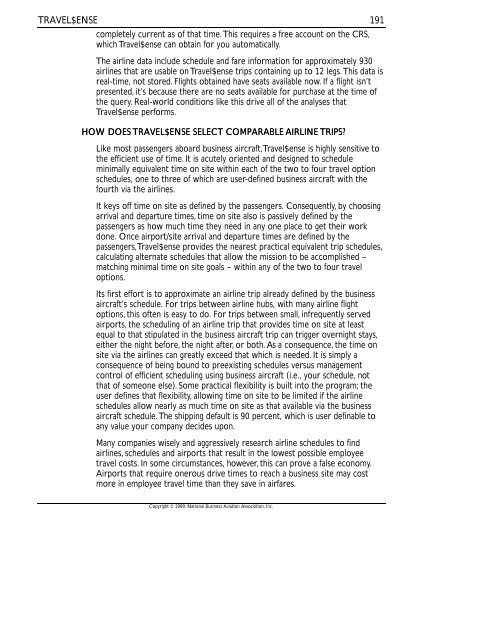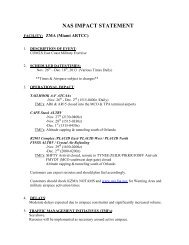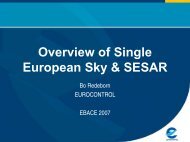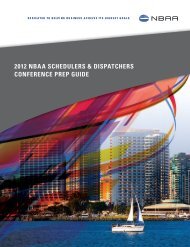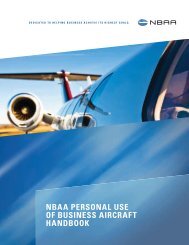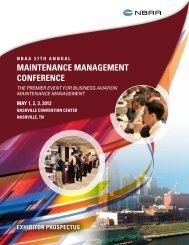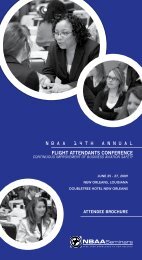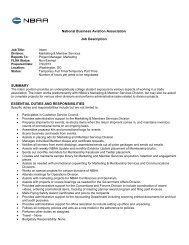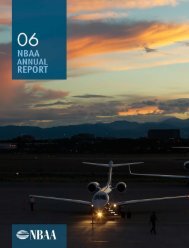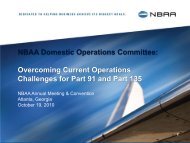Travel$ense User's Guide (PDF, 139 MB) - NBAA
Travel$ense User's Guide (PDF, 139 MB) - NBAA
Travel$ense User's Guide (PDF, 139 MB) - NBAA
- No tags were found...
You also want an ePaper? Increase the reach of your titles
YUMPU automatically turns print PDFs into web optimized ePapers that Google loves.
TRAVEL$ENSEcompletely current as of that time. This requires a free account on the CRS,which <strong>Travel$ense</strong> can obtain for you automatically.191The airline data include schedule and fare information for approximately 930airlines that are usable on <strong>Travel$ense</strong> trips containing up to 12 legs. This data isreal-time, not stored. Flights obtained have seats available now. If a flight isn’tpresented, it’s because there are no seats available for purchase at the time ofthe query. Real-world conditions like this drive all of the analyses that<strong>Travel$ense</strong> performs.HOW DOES TRAVEL$ENSE SELECT COMPARABLE AIRLINE TRIPS?Like most passengers aboard business aircraft, <strong>Travel$ense</strong> is highly sensitive tothe efficient use of time. It is acutely oriented and designed to scheduleminimally equivalent time on site within each of the two to four travel optionschedules, one to three of which are user-defined business aircraft with thefourth via the airlines.It keys off time on site as defined by the passengers. Consequently, by choosingarrival and departure times, time on site also is passively defined by thepassengers as how much time they need in any one place to get their workdone. Once airport/site arrival and departure times are defined by thepassengers, <strong>Travel$ense</strong> provides the nearest practical equivalent trip schedules,calculating alternate schedules that allow the mission to be accomplished –matching minimal time on site goals – within any of the two to four traveloptions.Its first effort is to approximate an airline trip already defined by the businessaircraft’s schedule. For trips between airline hubs, with many airline flightoptions, this often is easy to do. For trips between small, infrequently servedairports, the scheduling of an airline trip that provides time on site at leastequal to that stipulated in the business aircraft trip can trigger overnight stays,either the night before, the night after, or both. As a consequence, the time onsite via the airlines can greatly exceed that which is needed. It is simply aconsequence of being bound to preexisting schedules versus managementcontrol of efficient scheduling using business aircraft (i.e., your schedule, notthat of someone else). Some practical flexibility is built into the program; theuser defines that flexibility, allowing time on site to be limited if the airlineschedules allow nearly as much time on site as that available via the businessaircraft schedule. The shipping default is 90 percent, which is user definable toany value your company decides upon.Many companies wisely and aggressively research airline schedules to findairlines, schedules and airports that result in the lowest possible employeetravel costs. In some circumstances, however, this can prove a false economy.Airports that require onerous drive times to reach a business site may costmore in employee travel time than they save in airfares.Copyright © 1999, National Business Aviation Association, Inc.


